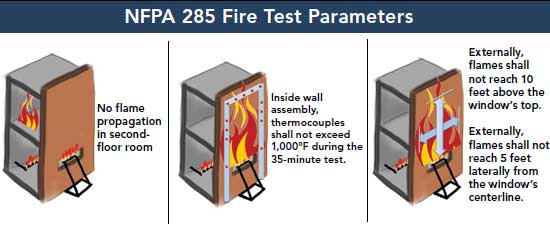Navigating Wall Assembly Fire Testing
Like EIFS, FRPs and MCMs with foam cores must also comply with IBC foam plastic requirements. When FRPs are installed in a condition not requiring an NFPA 285 assembly test, the cladding's flame spread index must be no more than 200, per ASTM E84, and prescribed cavity fireblocking is required. In this case, FRPs—which are composite materials made from reinforcing fibers impregnated with a polymer, molded into the desired shape and laminated onto a wood or plastic core—are limited to 10 percent of the surface area when the building separation is less than 10 feet.
HPLs also come as open and closed joint systems and run between 4 millimeters and 15 millimeters in panel thickness. In conditions not requiring an NFPA 285 assembly test, they are limited to a 10 percent area when the building separation is less than 5 feet, and similar to MCMs, the different core materials which different products are made from will have varying fire performance characteristics. HPLs are decorative exterior grade panels with cellulose fibrous material bonded with a thermosetting resin by a high-pressure process.
One noted exception for HPLs with regards to NFPA 285 is the cladding is allowed to rise up to 50 feet in areas of 300 square feet or less, per 4-foot vertical separation, and does not require NFPA 285 testing as long as the cladding doesn't self-ignite below 650°F, per ASTM D1929.
As for air and water barriers, referred to in the IBC as WRBs, generally all product types are considered combustible including: building wraps, self-adhered building wraps, self-adhered membranes, and fluid-applied membranes. Although the 2012 IBC does require that all WRBs go through testing, significant revisions and exceptions, based on material properties and fuel load potential, have been included in the 2015 IBC.
Because WRBs are a new NFPA 285 assembly test trigger in 2012, this means that the vast majority of products have not been tested. And although some manufacturers may claim that they have an NFPA 285 test report, buyer beware that the product may have only passed one test in one specific wall assembly configuration, which significantly limits designers.
 |
|
Images courtesy of DuPont Building Innovations |
It's also important to keep in mind that WRBs can be installed both under the insulation and over the insulation, and each positioning of the barrier requires a separate test.
For example, specifiers often choose to place the barrier under the insulation in order to increase the product's durability and longevity because it is protected by the foam. Also, in cases where the finish system is applied directly to the outside of the foam, the WRB must be located under the insulation. One other advantage to this approach is the specifier's ability to provide a drainage plane behind the foam for better moisture/condensation management.









